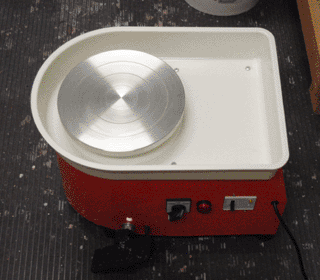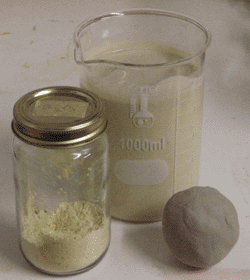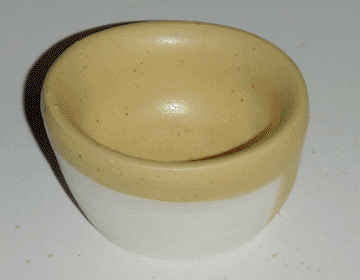


Although I initially intended to focus on the production of ceramic insulators, over the past two months I have gradually become interested in the field of pottery as a whole. Specifically, I have become interested in producing useful objects out of earthenware (low-fired, porous, sintered clay). Compared to stoneware and porcelain (high-fired, impermeable, vitreous clay), earthenware requires less precision and less expensive equipment, and is generally more accessible and available to amateurs, both from suppliers and in nature. Its downside, of course, is its sponge-like porosity. This attribute makes it necessary (for most applications) to cover the clay with a layer of glass (a glaze), and herein lies the difficulty.
Modern glazes rely heavily on pre-made powdered glass, known as "frit", which is melted onto the surface of the clay. This must be carefully selected to match the clay's coefficient of thermal expansion, so as to avoid either material cracking after firing. An older (and simpler) approach is to use a powdered flux that is capable of dissolving the clay itself, so that as long as the flux is fired sufficiently to absorb enough clay, it will be guaranteed to match it. Unfortunately, the most common material with the required characteristics (being insoluble in water, and dissolving clay to form a glass) is lead oxide, and its associated hazards are well-known. However, it is a relatively unknown fact that bismuth oxide behaves almost identically and without the attendant toxicity, so I decided to explore its use as a flux-based glaze.
Early experiments consisted of simply melting pure bismuth oxide onto dry clay, and this worked surprisingly well. However, this is hardly a practical method of application, so my next attempts involved mixing the oxide with various water-soluble binders (starches and gums) to make paint. This was more practical, but application was still difficult (particularly on the internal surfaces of pots) and the resulting coating was extremely uneven.
Ultimately, I decided to make a dipping glaze. Although this is the most expensive option (due to the cost of bismuth oxide and the large volume of glaze needed), it is also the simplest; the only tool needed is a bucket, and the only ingredients are water, clay, and bismuth oxide. The key, then, is finding the proper ratio of these ingredients. First, the water must contain enough clay to become slightly viscous and thixotropic; in my case, this was at a ratio of about 3:1 by weight. Then, enough bismuth oxide must be added to not only dissolve the clay contained in the glaze, but to also fuse to the object being glazed without losing its gloss. By slowly incrementing the amount of oxide (and firing test samples for each increment), I found this to be at about twice the weight of the clay. The final formula is as follows, by weight:
If these ingredients are thoroughly mixed together, a slurry results which produces a transparent yellow glaze at a temperature of around 1000-1060°C (cone 06-04). Any dry clay can be dipped into it before firing, but I found that the best results are achieved when the clay has previously been fired without glaze (bisque fired) to around the same temperature. The level of gloss is controllable, and depends on both the thickness of application and the porosity of the clay substrate, similar to applying varnish to wood. A typical example can be seen at the top of the page, where a five-second dip with a highly porous clay produces a satin finish after firing, which does not crack on cooling and is entirely watertight. The layer of glass is hard and insoluble, being neither scratched by steel nor etched by vinegar, and so appears to be useful for household dishes and containers; however, long-term testing is needed to confirm this, and I will conduct this personally over the coming months.
This glaze is highly adaptable, in both its use and in the materials required. Although for these experiments I used Amaco No. 25 white art clay and bismuth oxide, any clay body could likely be used to glaze itself, and if its toxicity can be tolerated (i.e. for electrical or other non-food applications), lead oxide is a one-to-one substitute as a flux. Even a clay mismatch between the glaze and the workpiece can be tolerated, I discovered, and I was able to successfully glaze a fragment of terra cotta with the above formula. Overall this recipe provides a simple alternative to contemporary glazing methods, and will hopefully lower the barrier to entry for experimenters interested in ceramics.